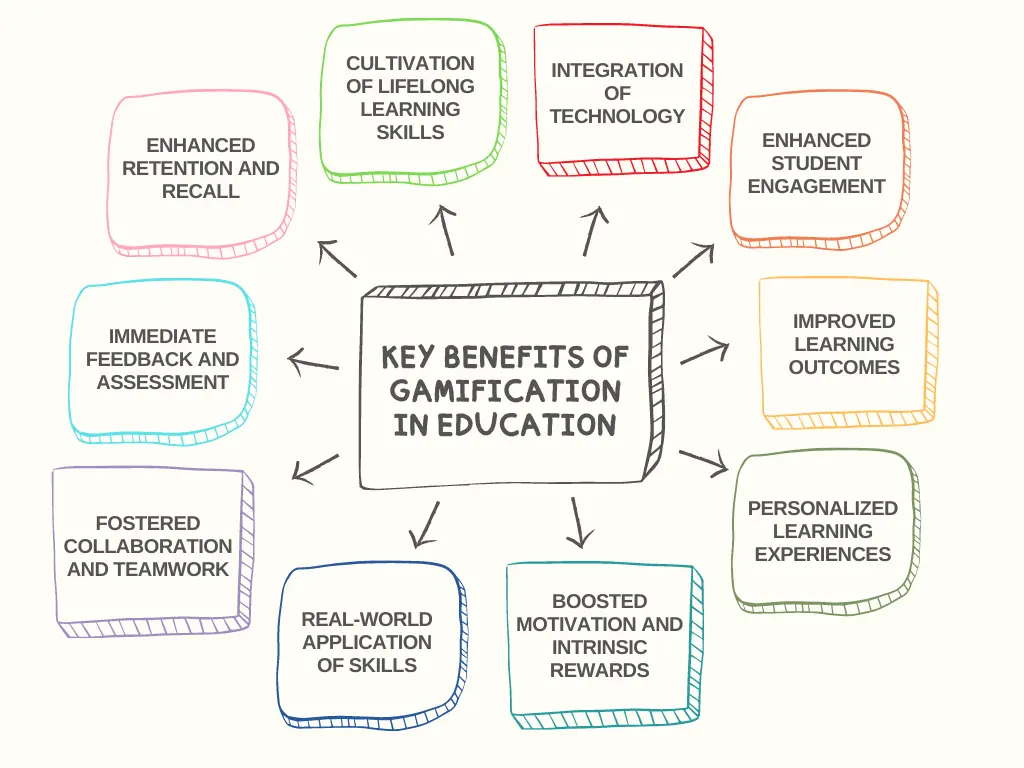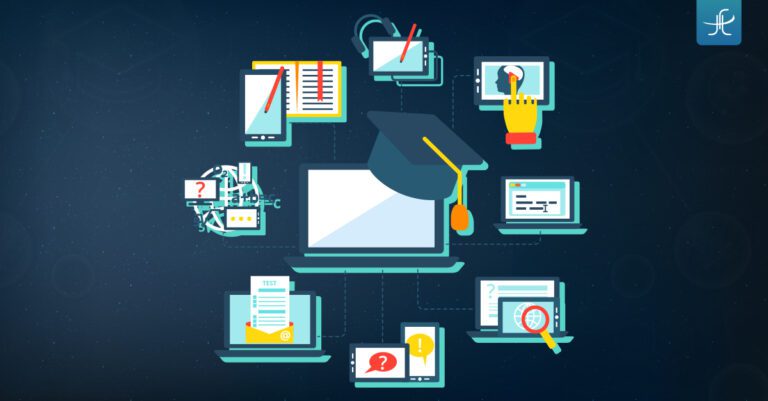Did you know?
According to Market Data Forecast, the size of the global gamification education market is predicted to grow from USD 1146 million in 2024 to USD 5412 billion by 2029, growing at a CAGR of 36.4% from 2024 to 2029.
In today’s rapidly evolving educational landscape, traditional teaching methods are being augmented by innovative approaches that leverage technology to enhance student engagement and learning outcomes. One such approach gaining significant traction is gamification in education.
Understanding Gamification in Education
Gamification in education signifies a significant departure from traditional teaching methods, ushering in an era where interactive-based learning methodologies take precedence. This approach actively engages students in the learning process, steering away from passive instruction towards immersive experiences akin to navigating through a captivating game.
Through interactive gamification, students are not just recipients of knowledge but active participants, collaborating with peers and applying critical thinking skills within a stimulating game-like environment.
At its essence, gamification in education tackles the pervasive issue of student engagement head-on. By tapping into students’ innate motivation and penchant for play, educators create dynamic learning experiences that resonate across various age groups and academic disciplines. These experiences captivate students’ attention, fostering a deeper understanding of academic concepts while making learning enjoyable and meaningful.
Recognized as a potent tool for enhancing student engagement and improving learning outcomes, gamification has gained traction in the education market. As technology continues to permeate every aspect of education, gamification emerges as a promising avenue for harnessing the potential of interactive technology in education.
In summary, gamification in education embodies a comprehensive approach to teaching and learning. By seamlessly integrating technology, fostering student engagement, and instilling a passion for lifelong learning, it paves the way for transformative educational experiences that empower students to thrive in an increasingly digital world.
Let’s now learn about the different benefits of gamification in education.
Top 10 Benefits of Gamification in Education
Gamification in education offers a myriad of benefits that not only enhance student engagement but also cultivate essential skills for success in the 21st century. Let’s go through these benefits one by one.

Enhanced Student Engagement
By infusing elements like points, badges, and rewards, gamification ignites students’ enthusiasm and active participation in learning activities, creating a vibrant classroom environment.
Improved Learning Outcomes
Through interactive gamification, students are challenged to think critically, collaborate with peers, and solve problems creatively, leading to deeper comprehension and mastery of academic content.
Personalized Learning Experiences
Gamification in education allows educators to tailor learning experiences to individual student needs and preferences, fostering a sense of ownership and empowerment in the learning process.
Boosted Motivation and Intrinsic Rewards
Gamified learning environments offer intrinsic rewards and instant feedback, motivating students to persist in their efforts and strive for academic success.
Real-World Application of Skills
Gamification in education provides opportunities for students to apply academic knowledge and skills in authentic, real-world contexts, preparing them for future challenges and career readiness.
Fostered Collaboration and Teamwork
Through gamified activities, students collaborate, communicate, and problem-solve together, honing essential interpersonal skills crucial for success in academic and professional settings.
Immediate Feedback and Assessment
Gamification facilitates real-time feedback and assessment, enabling educators to monitor student progress effectively and intervene when necessary to support student learning.
Enhanced Retention and Recall
The immersive and interactive nature of gamified learning experiences enhances information retention and recall, ensuring long-term mastery of key concepts.
Cultivation of Lifelong Learning Skills
Gamification fosters a love for learning by promoting curiosity, creativity, and resilience, nurturing students’ intrinsic motivation to pursue continuous growth and learning.
Legacy App Modernization and Custom Web App Development for a Leading Proptech Company
Integration of Technology
Leveraging interactive technology, gamification seamlessly integrates digital tools and platforms into educational practices, enriching learning experiences and aligning with modern pedagogical approaches.
If you’re interested in learning more about the integration of various technologies in the education industry, then you may like this: Benefits of Internet of Things (IoT) in the Education System
Challenges and Strategies for Implementing Gamification in the Classroom
Educators may encounter various obstacles when integrating gamified elements into their teaching practices. However, with proactive strategies and innovative approaches, these challenges can be effectively addressed.
Let’s explore some common challenges in educational gamification and strategies for overcoming them.
| Topic | Challenges | Solutions |
|---|---|---|
| Resistance to Change | Educator and student reluctance to adopt new teaching methodologiesFear of unfamiliar learning approaches | Communicate benefits of gamification Involve students in the decision-making process provide professional development opportunities Offer incentives for participation |
| Lack of Resources | Insufficient time, funding, and technological infrastructure | Leverage existing resources and collaborate with colleagues Seek external support (grants, partnerships) Utilize open educational resources (OERs) Share materials and ideas |
| Designing Effective Activities | Balancing fun and educational content Maintaining student interest while achieving learning objectives | Clearly define learning objectives Identify appropriate game elements Conduct pilot tests and gather feedback Collaborate with instructional designers/gamification experts |
| Assessment and Evaluation | Complexities in assessing diverse skills and competencies developed through gamification Limited traditional assessment methods | Develop innovative assessment strategies Incorporate formative assessment techniques Leverage digital tools and analytics platforms for data-driven assessment |
| Maintaining Engagement Over Time | Sustaining student interest as novelty wears off Ensuring continued engagement and motivation | Continuously refresh and update gamified activities – Introduce new challenges, rewards, and interactive elements Foster a sense of community and collaboration among students |
Real-World Examples of Gamification in Education
Gamification in education has gained significant momentum in recent years, with educators leveraging interactive-based learning approaches to enhance student engagement and learning outcomes. Let’s explore some real-world examples that showcase the effectiveness of gamification in the education sector.
Kahoot!
Kahoot! is a widely used platform that gamifies learning through interactive quizzes and trivia-style games. Educators can create custom quizzes on various subjects and topics, allowing students to participate in engaging learning activities while reinforcing their understanding of academic concepts.
Duolingo
Duolingo is a language-learning app that utilizes gamification to make language acquisition fun and interactive. Through a series of interactive lessons, quizzes, and challenges, users can learn new languages at their own pace while earning rewards and leveling up their skills.
Classcraft
Classcraft is a classroom management tool that gamifies the entire learning experience by transforming students into adventurers on epic quests. This app allows students to create personalized avatars and embark on quests, battles, and challenges, earning experience points and rewards for positive behavior and academic achievements.
Minecraft
Minecraft, a popular sandbox video game, has been creatively integrated into educational settings to promote interactive gamification. Educators use Minecraft to design virtual learning environments where students can explore historical landmarks, recreate scientific experiments, and engage in collaborative building projects.
CodeCombat
CodeCombat is an educational platform that gamifies the process of learning programming languages, such as Python and JavaScript. CodeCombat’s gamified approach to coding education makes learning to code engaging and accessible, appealing to students of all ages and skill levels.
Escape Room Edu
Escape Room Edu is an educational version of the popular escape room concept, where students work together to solve puzzles and complete challenges to “escape” the room. This gamified approach encourages teamwork, critical thinking, and problem-solving skills while reinforcing academic content.
Prodigy
Prodigy is a math-based educational game that uses gamification to make learning math skills more engaging and enjoyable for students. Through battles, quests, and challenges, students practice math concepts and earn rewards for their progress, motivating them to continue learning.
Zoo U
Zoo U is an online game that gamifies social-emotional learning by placing students in a virtual zoo where they must navigate social situations and solve problems to care for the animals. This gamified approach helps students develop empathy, communication skills, and emotional intelligence.
DragonBox
DragonBox is an educational app that gamifies algebraic concepts, making learning math more accessible and enjoyable for students of all ages. Through gameplay, students gradually learn algebraic principles and solve equations, building a strong foundation in mathematics.
Quizizz
Quizizz is a gamified quiz platform that allows teachers to create interactive quizzes and assessments for their students. With features like memes, avatars, and leaderboards, Quizizz makes learning fun and engaging while providing instant feedback to students and teachers.
Are You Ready to Revolutionize Education Through Gamification? Let Us Help You Unlock the Potential of Interactive Learning Experiences.
As a leading software development company, we specialize in implementing gamification solutions tailored to your educational needs.
Future of Gamified Learning in Education
The future of gamified learning holds tremendous promise as technology continues to evolve and educators explore innovative ways to engage students in the learning process.
Integration of Virtual and Augmented Reality Technologies
As technology continues to advance, the integration of virtual and augmented reality services holds immense potential for gamification in education.
VR and AR environments offer immersive experiences where students can explore virtual worlds, manipulate objects, and interact with digital content in ways that were previously impossible. For instance, history students can embark on virtual field trips to ancient civilizations, while science students can conduct virtual experiments in simulated laboratories. These technologies not only make learning more engaging and interactive but also cater to different learning styles and preferences, providing a personalized learning experience for each student.
Advancements in AI-Powered Adaptive Learning Systems
With the rise of artificial intelligence services (AI), adaptive learning systems are becoming increasingly sophisticated in catering to the individual needs and preferences of students.
AI algorithms analyze vast amounts of data to personalize learning content, adapt instructional strategies, and provide targeted interventions to support student progress. For example, an AI-powered adaptive learning platform can identify a student’s strengths and weaknesses in mathematics and adjust the difficulty level of math problems accordingly. Furthermore, by leveraging AI, gamification in education can offer personalized learning pathways that maximize student engagement and achievement.
Interactive Gamification of Soft Skills and Social-Emotional Learning (SEL)
In addition to academic content, there is a growing recognition of the importance of developing soft skills and social-emotional learning (SEL) competencies in students.
Also read: How to Choose an Offshore Development Center (ODC)
Gamification in education is increasingly incorporating elements that promote skills such as critical thinking, communication, collaboration, and problem-solving. For instance, students may participate in virtual simulations where they must work together to solve complex challenges or navigate social situations.
By gamifying soft skills and SEL, educators can create immersive learning experiences that not only enhance academic achievement but also foster holistic development in students.
Democratization of Gamified Learning Tools and Platforms
Education software development services are playing a key role in creating user-friendly and customizable solutions that cater to diverse learning needs. Furthermore, cloud-based platforms, open educational resources (OER), and mobile applications are providing educators with the flexibility to create and deliver gamified learning experiences both inside and outside the classroom.
By democratizing access to gamified learning tools, educators can empower students to take ownership of their learning and engage in personalized, self-directed learning experiences.
Bridging Formal and Informal Learning Contexts
Interactive gamification in education has the potential to bridge formal and informal learning contexts, providing students with opportunities for continuous learning and skill development.
By integrating gamified learning experiences into students’ everyday lives, educators can create seamless transitions between formal classroom instruction and informal learning environments. For example, students may engage in gamified learning activities at home through educational apps or online platforms, reinforcing concepts learned in the classroom and exploring new areas of interest.
Additionally, by bridging formal and informal learning contexts, gamified learning promotes lifelong learning and empowers students to become active, self-directed learners.
Conclusion
In conclusion, gamification in education stands as a powerful catalyst for transforming traditional learning paradigms into dynamic, engaging, and effective educational experiences.
By embracing gamification in education and leveraging its potential to foster lifelong learning, critical thinking, collaboration, and creativity, we can empower students to thrive in an increasingly digital and interconnected world.
If you are looking for a software development company to help with implementing gamification in education or any other related service, feel free to contact us. Jellyfish Technologies is here to help you innovate and revolutionize the way education is delivered.


